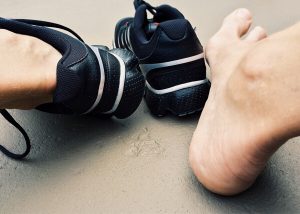Heel Pain: What You Need to Do to Eliminate It!
Have you ever experienced heel pain? Then you know how difficult it can be taking the first few steps when you get out of bed in the morning. If you’ve experienced this, you’re not alone. Up to 10% of adults experience this condition at some point in their lives.
The most common type of heel pain is the result of plantar fasciitis, an injury to connective tissue on the bottom of the foot. The plantar fascia (PF) runs from the inside side of the bottom of the heel and extends down the length of the foot connecting to the toes. The plantar fascia supports the arch of the foot, especially from just before your foot comes off the ground during walking.
As the foot lands on the ground, the foot pronates, which allows the foot to adapt to the surface. This causes the arch to lower or experience a stretch under the weight of the body. Immediately after that load is experienced, the heel lifts while the big toe extends, which allows the foot to propel the body forward. However, this increases tension on the plantar fascia. If that strain is excessive or overly repetitive, it can produce the clinical symptoms known as plantar fasciitis as fibers of the plantar fascia slightly tear from the connection on the heel.
If your heel or arch is painful, there are many things that can be done to make the tissue feel better – stretching, icing, arch supports, manual therapy, injections, medication, and modalities (i.e. ultrasound). Unfortunately, none of these treatments fix the root problem, and the symptoms are prone to return.
So what do you need to do to eliminate heel pain for good?
It’s as simple as this. Get an examination from a health care professional that understands how the function of other areas in the body can contribute to increased stress on the plantar fascia. This expert will look at the entire leg on the side of the pain, the opposite side leg, and even the trunk/core.
In the “same side leg”, the suspects are those dysfunctions that allow excessive pronation of the foot, or prevent the supination of the foot, which may be poor ankle joint motion, a tight calf muscle group, and/or weak buttock muscles.
In the “opposite side leg”, the causes of plantar fasciitis are conditions that prevent proper push off of that leg, which include poor ankle motion, tight calf muscle group, limited hip extension, and/or painful or limited big toe extension.
 In walking, and especially running, the buttock muscles support the legs, which allows for a mobile but stable pelvis. If the core muscles are not lengthened and activated, the pelvis will not have mobile stability. This can be determined by looking for weak abdominal muscles, loss of upper back motion, and even neck muscle fatigue and/or tightness.
In walking, and especially running, the buttock muscles support the legs, which allows for a mobile but stable pelvis. If the core muscles are not lengthened and activated, the pelvis will not have mobile stability. This can be determined by looking for weak abdominal muscles, loss of upper back motion, and even neck muscle fatigue and/or tightness.
If you’ve had heel pain and the treatments you received haven’t led to long-term relief, consider visiting the heel pain experts at Kinetic Edge Physical Therapy. Without an analysis that is looking to determine the root cause of plantar fasciitis, the permanent solution will not be found. You need a health care professional that can treat both the symptoms and the primary cause.
If you would like to learn more about successful treatment strategies for heel pain, contact our clinic today at 866-588-0230 to claim one of the 10 slots we’ve set aside to provide free screens for people with heel pain. Call today! They won’t last long.




